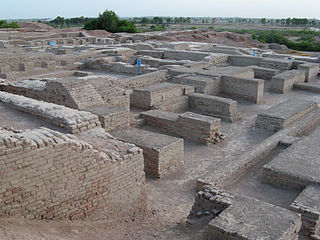Mohenjo-Daro Was a Feat of Early Urban Planning
by Ali Khan, age 16

According
to the Sanskrit
Rigveda
,
a series of ancient Hindu texts, Aryan invaders led by the god Indra,
marched into India around 1500 BCE. Indra was known as the “fort
destroyer.” The 90 forts and 100 ancient castles worked by Indra’s
army were stuff of myth until archaeological excavations in the
1920’s and 1930’s proved otherwise.
Decades
later, during the British occupation of India in 1944, Sir Mortimer
Wheeler became Director-General of Archeology for India. The British
archeologist re-excavated huge mounds of land across territory
located in modern-day Pakistan. Almost 100 villages, towns and cities
were discovered across a rough triangle. The triangle extended 500
miles up the Indus River and reached 600 miles along the river’s
mouth pouring into the Arabian Sea.
Wheeler uncovered two cities revealed to be the
twin capitals of the Harrappan Empire: Harrappa in the north and
Mohenjo-Daro, meaning “mound of the dead,” to the southwest. This
empire was part of the Indus Valley civilization, the largest
pre-classical society in the world.
Built around 2500-2100 BCE, the remarkably
similar cities, with perimeters of over 3 miles built entirely of
kiln-fired brick, made them the world’s largest urban settlements
of that time.
Square in outline and laid out along the lines
of a grid, Mohenjo-Daro was the first planned city. The city was made
up of a dozen main streets between 30 to 45 feet wide. These streets
divided the city into 12 blocks. Eleven of the blocks were composed
of many close-packed brick houses that made up homes, stores and
workshops. The twelfth block, set aside from the main city on a
rectangular citadel mound, included chief buildings. These buildings
were the Assembly Hall and the Great Bath. There was also the Civic
Granary, platforms used for pounding grain and storing wheat and
rice.
Most houses had a basic but spacious layout, a
style representative of the period’s architecture. Each included a
central courtyard and a well that was surrounded by several rooms,
with stairs leading to an upper story. Not many houses had doors or
windows opening to the main streets, presumably due to privacy,
security, or even to keep out noise from outside.
Although most ancient societies were ruled by
priests, kings, or living gods, the Indus civilization left no clear
evidence of its rulers' idenities. Several figurines representing
deities uncovered by archaeologists in Mohenjo-Daro bring up hints
that their religion was a precursor to Hinduism. The Great Bath, a
brick tank that was used for communal spiritual cleansing led by
priests, may have been an influence leading to ritual bathing, a
practice, maintained in Hinduism today.
Like many renowned cities, Mohenjo-Daro was
built around a river valley. Although the river was a valuable
natural resource, the delta plains of the Indus Valley flooded often
because they lie below the water table. By 1900 BCE the cities were
in decline. This was due either to constant flooding or an exhaustion
of the timber supply used to make huge quantities of brick. After
scavenging for limited resources, the people of Mohenjo-Daro were no
match for the Aryan army.
Although Mohenjo-Daro was an architectural
masterpiece and one of the most advanced urban developments at its
time, its planners may not have anticipated the many floods of the
Indus.
[Source:
The Atlas of
Mysterious Places
]
|

